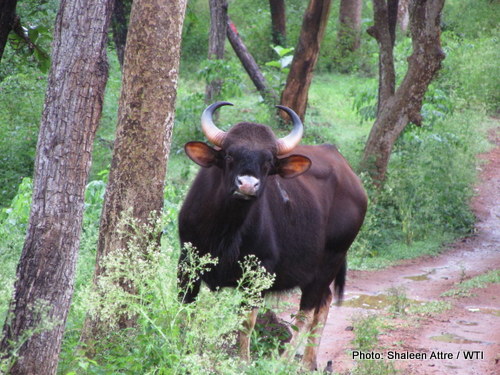Kotagiri, Nilgiri Biosphere Reserve, Sept 30, 2014: To enable a conflict-free existence between humans and gaurs (Bos gaurus) in the region, the Keystone Foundation with assistance from Wildlife Trust of India (WTI) has started a Rapid Action Project (RAP), supported by Charities Aid Foundation India (CAF India), in areas in and around Kotagiri, an important refuge for the gaur.
Reports of gaur sightings have been increasing in the upper plateau of the Nilgiris. Sightings have also become common in the tea/coffee plantations and agricultural fields. Growing urbanisation has led to a massive degradation of habitat of the gaur and recent times have seen a rise in reports of negative interactions with humans, especially by vegetable farmers.
Further explaining the need of the project, Radhika Bhagat the Head of Wild Aid Division, under which the RAP is being carried out, said, “Gaurs are large bovines and will naturally go to the first available food source. In an area like the Niligiris, when you have a high density of the species in a vastly fragmented habitat and they have to inevitably share the same space as humans, chances of conflict increase especially in the agricultural lands. While so far there have been no fatal retaliatory attacks on the animal, a few people have lost their lives in conflict situations. To nip the problem before it escalates to a bigger level, we are lending our full support to the Keystone Foundation as they go ahead with various mitigation measures.”

Some of these measures include identifying potential gaur safe havens within the landscape and identifying gaur corridors with technical advice from WTI, installing signages at critical crossing zones and developing multi-lingual information and awareness material for gaur conservation in human dominated landscapes.
“It is good that there is an attempt being made to assess the habitat of gaurs and make plans to locally conserve them, particularly by anticipating a possibility of retaliatory killings. The species has also been long targeted for its meat, contributing to the dwindling numbers,” said Jose Louies, Regional Head of South India for WTI.
A two-day Doddu Habba or Gaur Festival was also organised by the Keystone Foundation at Kotagiri, in August. The event was being organised in collaboration with the Wildlife Trust of India, the Hill Area Development Programme, CAF India and the Rufford Foundation. The motive behind the festival was to spread awareness on tolerance towards wildlife among the local populace. The festival brought together artists, musicians, theatre artists and storytellers from the Nilgiris, Kerala, Odisha, and North East India in support of the majestic animal. It celebrated the gaur, not only as a wild animal, but also as a symbolic representation of man’s coexistence with nature.
“The Gaur is a symbol of coexistence between humans and nature. While they are not yet considered a species of concern in an urban landscape, frequent and sometimes prolonged interactions with gaur have generated a buzz in town. We would like to use the buzz to spread awareness and get people to participate in the conservation of the charismatic species,” added Sumin George, of the Keystone Foundation.
The Western Ghats and their outflanking hills in South India constitute one of the most extensive extant strongholds of the gaur, with good numbers in Wayanad – Nagarahole – Mudumalai – Bandipur complex, with an estimated population of 12,000-22,000 in the country (Ranjitsinh 1997), although there is no confirmed data. According to IUCN Red List, which lists the Bos gaurus as Vulnerable, the global population is estimated to be around 13,000–30,000 animals, indicating a total of 5,200–18,000 mature individuals.